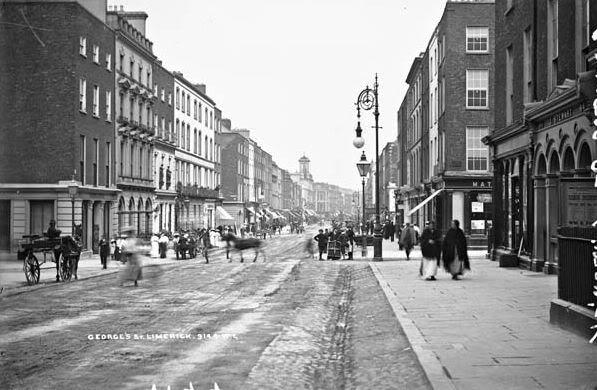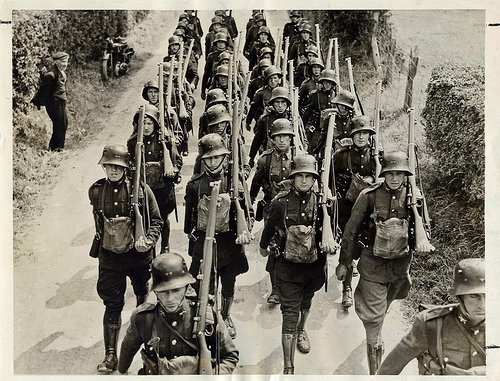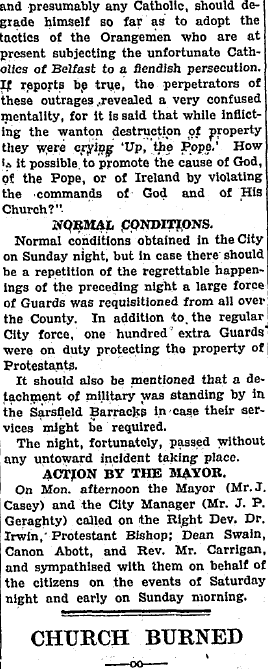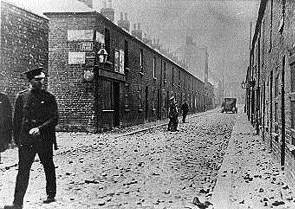A Limerick riot

Brian Hanley looks at a riot in Limerick in 1935
At about 10.30pm on the 20th July 1935, a Saturday night, Joseph Gibbons, a 40-year old sign-writer with the Great Southern Railway Company, smashed the window of a hardware shop in Limerick’s Upper William Street. He then walked to his home, less than 50 yards away, in Lower Gerald Griffin Street.
A crowd gathered at the scene of the window breaking and when Gardaí arrived they were given Gibbons name in connection with the incident. Two Gardaí went to his home, where they found the suspect drunk and bleeding from both hands. When they escorted Gibbons onto the street he became abusive and a crowd gathered demanding his release. Soon up to 300 people, mostly young men, had gathered in the area around Good’s shop.
The riot began with some drunken smashing of windows and escalated when a crowd gathered resisting the arrest of the perpetrator.
After taunting Gardaí this crowd then moved off towards Catherine Street, gathering support from, what police referred to as, ‘irresponsible youths’ along the way. A clash erupted outside a hall in Catherine Street and some of the youths were chased back towards William Street where they smashed a shop window. There were now perhaps 600 people altogether, but the crowd split into groups of about 200 and took to the back streets.
Efforts by the Gardaí to contain them were met with volleys of stones and bottles. Swelled by others arriving from the direction of the railway station, they broke windows in various premises around Pery Square and the Crescent in O’Connell Street. All the time the crowds were pursued by Gardaí who tried to move them on while also leaving some officers to guard the buildings which had been attacked.

The rioters were pushed back down O’Connell Street but managed to regroup and secure more ammunition by tearing down and breaking up hoarding from outside the National Bank (which was undergoing renovations).
One man was apprehended after smashing a nearby chemist shop window but as Gardaí tried to take him away the rioters rushed them and a shot was fired from the crowd. In response a detective fired three shots over the heads of the rioters. The Gardaí then baton-charged again but as the crowd fled, more windows were smashed in auctioneers and draperies along Henry Street and Patrick Street.
Order was not restored until the Irish Army was deployed to back up the Gardaí
The Gardaí were hindered in their efforts by the fact that the rioters had again split into different groups and were attacking various places simultaneously, including private homes in Thomondgate and Shelbourne Avenue. By midnight the streets were becoming congested with people leaving cinemas and dances and the Gardaí were finding it difficult to separate the rioters from the general public. The core of the troublemakers had armed themselves with stones, timber poles and other weapons and seemed determined to continue the fighting.
At this point Gardaí asked for military aid and a party of troops from Sarsfield Barracks were deployed to back them up. The soldiers, with fixed bayonets, formed a cordon across O’Connell Street, and when Garda reinforcements arrived from other districts, another baton charge took place. But it was after 2am when calm was restored to Limerick city centre. Despite the numbers involved, Gardaí only managed to detain five people (though 20 were later brought before the courts on charges relating to the trouble). The following day the city centre was calm, though large numbers of sightseers gathered around the premises that had been damaged while Gardaí continued to mount extra patrols.[1]
The Sectarian Dimension

In some senses what occurred in Limerick was not unusual either in the context of the time or in the history of riots more generally. Street disorder of this sort was not uncommon in the Free State. There had been much larger riots involving Blueshirts and republicans in Tralee and elsewhere in previous years during which troops had also been deployed.
A contested Saturday night arrest in an inner-city area, where relations with the police are often strained is an almost universal feature of urban social disorder. Contradictory accounts of such events are also common. In this case Gardaí claimed that Gibbons was abusive, threatened to break other windows and that one of their colleagues was assaulted by an onlooker (Gibbon’s brother-in-law).
But other witnesses testified that Gibbons had drunkenly but accidentally fallen against Good’s shop window and that the Gardaí arresting him had behaved aggressively, hitting a woman.[2]Often when trouble begins, people who start off as onlookers can be drawn into the violence while the perception of those on the receiving end of baton charges markedly differs from that of the police. Shops and other properties are also often attacked, as part of the general melee, to secure ammunition for use against police or by opportunists seeking loot.
Belfast had just been engulfed in the worst sectarian conflict since 1922; 2,000 people, mainly Catholics, were forced from their homes, Catholics were driven out of workplaces and several were killed in sectarian attacks.
But the most notable feature of the Limerick violence was that it was aimed exclusively against Protestant property. All of the shops which had their windows smashed were Protestant-owned. Also attacked were the Mission Hall in Mallow Street, the Protestant Young Men’s Club in O’Connell Street, the Masonic Club in the Crescent and the Baptist Church near O’Connell Avenue. On several occasions rioters tried to enter these buildings with the intention of wrecking them but were only prevented from doing so by baton charges.
There was an attempt to set the Presbyterian Church at Mount Kennett on fire and Gardaí managed to head off an attack on St. Michaels, the Anglican church in Pery Square. The homes of two clergymen, Rev. Canon Abbott in Barrington Street and Rev. Archdeacon Waller in Upper Mallow Street had their windows broken. Three more private houses where Protestants families lived were also stoned. Gardaí considered that some of the crowd intended to attack every building in the city associated with Protestants, reporting that rioters promised that‘we won’t ,’let a Protestant house standing’.
During the night Gardaí were detailed to protect not just business premises and churches but also Protestant homes in Limerick’s suburbs. The sectarian aspect to the trouble was apparent from the start. The owner of the first shop in William Street to have its window broken, allegedly by Joseph Gibbons, was Joseph Good,a 52- year old Methodist. Gardaí arresting Gibbons were taunted by on-lookers asking ‘Are ye Catholics?’, while those contesting his detention asserted ‘We’re Catholics, anyhow.’
‘Lowered themselves to the level of the Orange miscreants of Belfast’

The major context for the events, which Gardaí, the press and many those involved in the attacks themselves agreed, was that they were a response to what was happening in Northern Ireland. Belfast had just been engulfed in the worst sectarian conflict since 1922.After several months of rising tension riots had broken out during the Orange parades on 12th July. Over the next week, 2,000 people, mainly Catholics, were forced from their homes, Catholics were driven out of workplaces and several were killed in sectarian attacks.
The violence (which also spread to Portadown and Coleraine) saw thousands rioting, gun battles, sniping and the deployment of British troops.[3] There was a great deal of anger among nationalists across Ireland at what was regarded as the start of another ‘pogrom.’ As the Irish Independent asserted when it condemned the Limerick events, ‘it is obvious that these attacks are in the nature of reprisals for the savage persecution of Catholics in Belfast.’[4]
The Limerick riot was just one of a series of assaults on Protestants in the Free State during July 1935. Most of these incidents, which ranged from arson attacks to window smashing, the painting of sectarian slogans on walls and threatening letters, were carried out by individuals or small groups operating in the dead of night.[5]One exception was Galway city, where a strike in protest at the events in Belfast developed into a march demanding that Protestant workers be dismissed. It saw several hundred take to the streets.[6]
The most notable feature of the Limerick violence was that it was aimed exclusively against Protestant property
But Limerick was the only location that saw large crowds violently attack Protestant targets.Some saw this as evidence of the city’s tradition of militant Catholicism. The left-wing Republican Congress newspaper argued that the riot ‘arose out of bigoted teachings among a population unusually well organised in Catholic bodies. There is no other explanation for an anti-Protestant pogrom in this predominantly Catholic city.’[7] The Irish Times acidly commented that Limerick ‘seems to be jealous of Belfast’s reputation’ for sectarianism.[8]In fact the morning after the riot, Catholic clergy in Limerick roundly denounced those who took part as ‘un-Irish, un-Catholic, uncharitable and unpatriotic.’
The powerful Arch-Confraternity claimed that those who attacked Protestant property had, ‘lowered themselves to the level of the Orange miscreants’ of Belfast.[9]Local politicians of all parties echoed these condemnations. Neither had sectarianism been a major factor in Limerick during the revolutionary period.[10]
Nevertheless the intensity of Catholic religiosity in Limerick may have been a factor in the violence. The way the riot developed following the minor incident at Good’s hardware shop, and the fact that, despite the numbers involved, the violence was so selective – with not one non-Protestant shop having its windows broken – would also point to some level of organization.
Was economic resentment a factor? As well as owning the hardware shop in William Street, Joseph Good was also a landlord with property in the Lower Gerald Griffin Street area. Joseph Gibbons was actually one of his tenants in July 1935. A substantial number of businesses in Limerick city were Protestant-owned in a city that was overwhelmingly Catholic.
But the fact that places of worship and private homes were also attacked suggests that resentment of Protestant economic privilege was not the primary factor in the violence. Instead the Limerick riot was a dramatic example of how anger over the treatment of Catholics in Belfast during 1935 expressed itself in attacks on southern Protestants. These attacks never came near the intensity of the violence in the North; nobody was seriously injured in any of the incidents in the Free State. However in all of the cases, despite the influence of events north of the border, the circumstances and individuals suspected of being involved all differed, something that I hope to examine in a future article.
Dr. Brian Hanley is the author of; The IRA A Documentary History, 1919-2005, The IRA: 1926-1936, and with Scott Millar, The Lost Revolution, The Story of the Official IRA and the Workers’ Party. His is currently researching the impact of the Northern Ireland conflict on southern Ireland. He teaches History at University College Dublin. You can read more posts by him here.
References
[1]Accounts from Limerick Leader, 27 July 1935, Irish Times, 22 July 1935 and Garda reports in Department of Justice 2008/117/565 (National Archives of Ireland).
[2]Limerick Leader, 10 August 1935.
[3] The majority of the 11 people killed in the 1935 riots were Protestants, but most of those forced from their homes (86%) and injured were Catholic. A.C. Hepburn, ‘The Belfast Riots of 1935’ in Social History, Vol. 15, No. 1 (Jan. 1990) pp. 75-96.
[4]Irish Independent, 22 July 1935.
[5] See reports in Irish Independent, Irish Times and Irish Press, 22-30 July 1935.
[6]Irish Press, 24 July 1935.
[7]Republican Congress, 27 July 1935.
[8]Irish Times, 27 July 1935.
[9]Limerick Leader, 27 July 1935.
[10] John O’Callaghan, Revolutionary Limerick: the Republican Campaign for Independence in Limerick, 1913-1921 (Dublin, 2010) pp. 113-14, 203-04. Protestant property in the city centre had been attacked during rioting in October 1912 however. O’Callaghan, pp. 32-32.